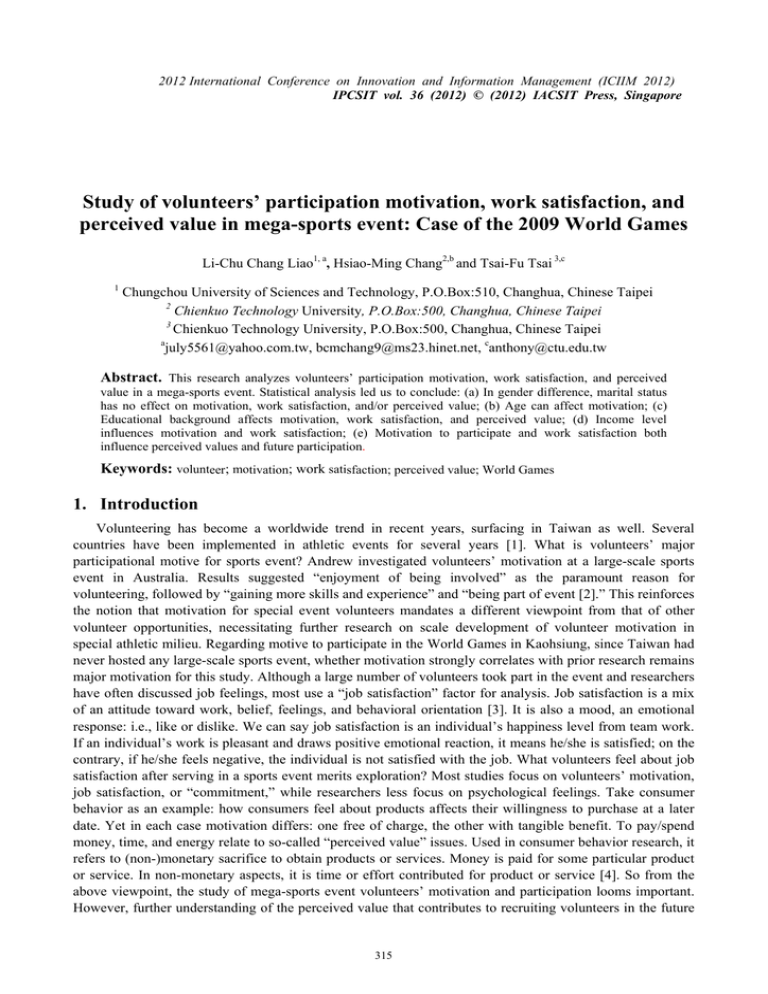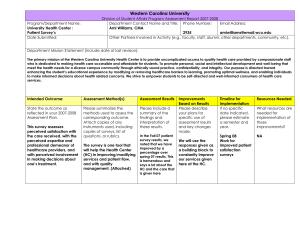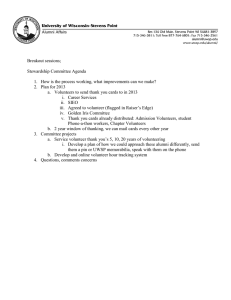Study of volunteers’ participation motivation, work satisfaction, and
advertisement

2012 International Conference on Innovation and Information Management (ICIIM 2012) IPCSIT vol. 36 (2012) © (2012) IACSIT Press, Singapore Study of volunteers’ participation motivation, work satisfaction, and perceived value in mega-sports event: Case of the 2009 World Games Li-Chu Chang Liao1, a, Hsiao-Ming Chang2,b and Tsai-Fu Tsai 3,c 1 Chungchou University of Sciences and Technology, P.O.Box:510, Changhua, Chinese Taipei 2 Chienkuo Technology University, P.O.Box:500, Changhua, Chinese Taipei 3 Chienkuo Technology University, P.O.Box:500, Changhua, Chinese Taipei a july5561@yahoo.com.tw, bcmchang9@ms23.hinet.net, canthony@ctu.edu.tw Abstract. This research analyzes volunteers’ participation motivation, work satisfaction, and perceived value in a mega-sports event. Statistical analysis led us to conclude: (a) In gender difference, marital status has no effect on motivation, work satisfaction, and/or perceived value; (b) Age can affect motivation; (c) Educational background affects motivation, work satisfaction, and perceived value; (d) Income level influences motivation and work satisfaction; (e) Motivation to participate and work satisfaction both influence perceived values and future participation. Keywords: volunteer; motivation; work satisfaction; perceived value; World Games 1. Introduction Volunteering has become a worldwide trend in recent years, surfacing in Taiwan as well. Several countries have been implemented in athletic events for several years [1]. What is volunteers’ major participational motive for sports event? Andrew investigated volunteers’ motivation at a large-scale sports event in Australia. Results suggested “enjoyment of being involved” as the paramount reason for volunteering, followed by “gaining more skills and experience” and “being part of event [2].” This reinforces the notion that motivation for special event volunteers mandates a different viewpoint from that of other volunteer opportunities, necessitating further research on scale development of volunteer motivation in special athletic milieu. Regarding motive to participate in the World Games in Kaohsiung, since Taiwan had never hosted any large-scale sports event, whether motivation strongly correlates with prior research remains major motivation for this study. Although a large number of volunteers took part in the event and researchers have often discussed job feelings, most use a “job satisfaction” factor for analysis. Job satisfaction is a mix of an attitude toward work, belief, feelings, and behavioral orientation [3]. It is also a mood, an emotional response: i.e., like or dislike. We can say job satisfaction is an individual’s happiness level from team work. If an individual’s work is pleasant and draws positive emotional reaction, it means he/she is satisfied; on the contrary, if he/she feels negative, the individual is not satisfied with the job. What volunteers feel about job satisfaction after serving in a sports event merits exploration? Most studies focus on volunteers’ motivation, job satisfaction, or “commitment,” while researchers less focus on psychological feelings. Take consumer behavior as an example: how consumers feel about products affects their willingness to purchase at a later date. Yet in each case motivation differs: one free of charge, the other with tangible benefit. To pay/spend money, time, and energy relate to so-called “perceived value” issues. Used in consumer behavior research, it refers to (non-)monetary sacrifice to obtain products or services. Money is paid for some particular product or service. In non-monetary aspects, it is time or effort contributed for product or service [4]. So from the above viewpoint, the study of mega-sports event volunteers’ motivation and participation looms important. However, further understanding of the perceived value that contributes to recruiting volunteers in the future 315 remains practical issue worth exploring. The purpose of this study was: a. to understand influential factors of demographic variables for sports tournament volunteer motivation, job satisfaction, and perceived value. b. to analyze impact of volunteer motivation and job satisfaction on perceived value of volunteer service. 2. Method Subjects and Sampling. This study targeted selected and trained volunteers for the World Games in Kaohsiung. Purposive sampling approach was employed, with 690 questionnaires distributed (at 30 different sites) and 50 discarded as incomplete, for a total of 640 valid questionnaires collected. Survey Questionnaire. This research used a scale of “sports tournament volunteer motivation, job satisfaction, and perceived value.” Mainly based on relevant empirical research, it was divided as follows: (1) participation motivation (24 items); (2) job satisfaction (17 items); (3) perceived value (3 items); and (4) demographic variables, such as gender, marital status, children, age, education level, occupation, average and monthly income. Data Analysis. With valid questionnaire items, statistical steps include: (1) to construct reliability and validity, exploratory factor analysis, and Cronbach α reliability methods were established; (2) t-test and one-factor multivariate analysis evaluated demographic variables, volunteer motivation, and job satisfaction, as well as perceived value differences; (3) multiple regression sought to understand motivation for volunteering and prediction of work satisfaction on perceived value. Validity and Reliability. Based on factor analysis, four factors in the participation motivation scale were extracted and designated by characteristics: participation in international tournament, peer confirmation, enhance international perspectives, and fulfill social obligations. Cumulative variance is 61.86 (Cronbach, α=.90). Also, by factor analysis for “job satisfaction,” four factors were extracted and likewise named: welfare system, peer confirmation, interaction with peers, and self-confidence and achievement. Cumulative variance of this part was of 67.92% (Cronbach, α=.92). However, the perceived value questionnaire only three items unable to factor analysis, so can only reliability analysis with the letter directly. After analysis, the cronbach, α is.87, that have good reliability. 3. Result Demographic data and participation behavioral analysis. Based on t-test, results showed gender differences in volunteer “participation motive” (t=-1.009, p>.05), “job satisfaction” (t=-1.363, p>.05), and “perceived value” (t=-1.518, p>.05) as insignificant. In marital status, t-test showed that in “participation motivation” (t=.672, p>.05), “job satisfaction” (t=.032, p>.05), and “perceived value” (t=-.106, p>.05) no significant difference appeared. In terms of child bearing, t-test showed that volunteers with or without children in their “participation motive” (t=-1.595, p>.05) displayed no significant difference. However, “job satisfaction” (t=-3.125, p<.05), and “perceived value” (t=-3.087, p<.05), there was a significant difference. From the average point of view, subjects with no children have higher means in “job satisfaction” (M=32.29,>31.85) and “perceived value” (M=12.35, >11.69). Among different ages, single-factor multivariate analysis showed different age groups of volunteers in “job satisfaction” (F=1.062, p>.05), and “perceived value” (F=.871, p>.05) with little or no difference; whereas “participation motive” (F=2.744, p<.05) exhibited marked difference. Post hoc comparison showed volunteers under age 20 performing significantly higher than the age 41-50 bracket. For different educational levels, single-factor multivariate analysis showed different education levels of volunteers in “participation motivation” (F=1.337, p>.05), “job satisfaction” (F=.858, p>.05), and “perceived value.” Among these no significant difference emerged. As for occupation, single-factor multivariate analysis showed volunteers’ “participation motivation” (F=1.498, p>.05), “job satisfaction” (F=.956, p>.05), and “perceived value” (F=.673, p>.05), not significantly different. For income bracket, single-factor multivariate analysis showed no significant difference in volunteers’ different income regarding “perceived value” (F=1.418, p>.05), but stark difference in “participation motivation” (F=9.468, p<.05) and “job satisfaction” (F=3.788, p<.05). Post hoc comparison indicated that in “participation motivation,” those with monthly income below $20,000 316 scored significantly higher than those earning $20,001-40,000; in “job satisfaction,” monthly income below $20,000 is significantly higher than those with no income. Regression analysis for motivation and perceived value. Results showed predictable variables as motivation to take part in international sports events, identity of volunteer activities, broaden personal international vision,” and fulfill our social obligations. “Perceived value” was of criterion variables. Then, we took entry regression analysis. Results showed that “participation in international tournament” (t=4.367, p<.05), “identity of volunteer participation (t=6.285, p<.05), and “broaden personal vision” (t=5.395, p<.05) three factors are predictive, R2 =. 375, indicating perceived value could be predictable up to 37.5%. In “job satisfaction,” three out of four factors reached significant levels: “welfare” (t=9.999, p<.05),”peer confirmation” (t=5.487, p<.05), and “self-confidence and achievement” (t=8.877, p<.05), R2=.603. Those factors are predictable for “perceived value,” reaching 60.3%. 4. Discussion Analysis of demographic variables for participating behaviours. Based on t-test analysis, gender difference in “participation motivation,” “job satisfaction,” and “perceived value” factors yield no significant difference, indicating that volunteers in the above three factors are alike. But as with Downward, Lumsdon and Ralston’s probe of the 2002 British Commonwealth Games volunteer study of gender differences, it differentiates between male and female volunteers [5]. In comparison with this study, cultural differences should affect results. Regarding “participation motive,” “job satisfaction,” and “perceived value” vis-à-vis marital status, no significant difference emerged. While gender and marital status did not affect motivation, job satisfaction and perceived value, results indicated volunteers with no children in “job satisfaction” and “perceived value” as higher than those with children. In fact, number of children is an indicator often affecting participation, mainly due to limited amount of time they can contribute. If children are still young and need care, impact factor is greater. Related studies found “family” as a key factor affecting participation. Age made no significant difference in “job satisfaction” and “perceived value” there; we found “participation motivation” significantly higher in those under age 20 versus 41-50. For the Kaohsiung World Games, the majority of volunteers trained came from colleges and universities. According to researchers’ experiences, college students have high motivation to participate. They do not want to miss this big sports event, whereby they can learn relevant experience and knowledge. From the above reasoning, we found the best reason for interpreting “participation motives” of volunteers under age 20. Another study saw education level and occupation not affecting “participation motivation,” “job satisfaction” and/or “perceived value.” Decision to participate was obviously not impacted by the above demographic variables, but income level did affect “perceived value,” especially for those with monthly income below $20,000: i.e., perceived significantly higher than those with no income and those with of $20,001-40,000. In “job satisfaction,” those with monthly income below $20,000 rank significantly higher than those with no income. Most with income below $20,000 are students. Why would no-incomers’ “perceived value” prove lower? The main reason is that some students had no income but a high level of participation motivation. Still, with lack of “monetary compensation,” there remain some considerations related to money paid for transportation, time, and worthwhile effort. These last issues should bulk as major factors when selecting students to take part in large-scale sports events in Taiwan. Volunteers are free to serve in activities. Students’ lack of mature thinking at times yields lower “perceived value.” 5. Analysis of Regression analysis for motivation and perceived value Analysis showed motivation “to participate in international tournament,” “identify volunteer activities,” and “broaden international perspective,” three factors predictable for “perceived value” at 37.5%. The above illustrates major reasons attracting volunteers to take part in the tournament, especially for this large international sports event. Results of analysis were associated findings [2] [4]. As for “job satisfaction,” we discovered “welfare system,” “peers’ positive feedback,” and “self-confidence and achievement,” as three factors predictable for “perceived value” reaching 60.3%. These indicate volunteers’ perceived value of service emanates from “job satisfaction,” especially benefits, awards, life measures, work autonomy and training. In addition to volunteer services, accessing recognition and peer appreciation, whether volunteer 317 activities enhance “self-confidence” and “sense of achievement,” are factors that impact volunteers’ perceived value. Practical suggestions. This study employed volunteers in the World Games as subjects, finding “job satisfaction” most influential on “perceived value.” Also, “participation motive” played an influential role. We thus recommend that organizations intending to host large-scale tournament events emphasize uniqueness and significance to boost people’s motivation for volunteering, making them eager to undertake volunteer activities. In addition, in terms of services proposals, the host should provide comprehensive “benefits and reward system,” such that volunteers work as self-organizers to achieve given tasks while obtaining positive feedback from peers and thereby construct “self-confidence and achievement.” They will feel these volunteer activities, time spent and efforts they contribute worthwhile. Suggestions for further study. The study mainly employed World Games volunteers’ “participation motive” and “job satisfaction” as predictive variables to understand their “perceived values.” In fact, researchers found volunteer behavior complicated because, like consumer behaviour, volunteers’ willingness to participate in future related tasks is high. Hence, future research may consider further participation of volunteers’ willingness and influencing factors. Besides, they can continue to explore whether volunteers’ motive differs in various sports events. 6. References [1] P. Chelladurai., Human resource management in sport and recreation, Human Kinetics, Champaign, IL (1999). [2] J. Andrew., “Motivations and expectations of volunteers involved in a large scale sports event”, Leisure, Vol.3 No.30 (1996), 21-24. Australian [3] D.W. Organ, and T. S. Bateman, Organizational behavior (4th), Irwin, New York, NY (1991). [4] S. Fairley, P. Kellett, and B. C. Green, “Volunteering abroad: Motives for travel to volunteer at the Athens Olympic Games”, Journal of Sport Management, Vol. 21 (2007), 41-57. [5] C. Downward, L. Lumsdon, and R. Ralston, “Gender differences in sports event volunteering: 2002 at the XVII Commonwealth Games”, Managing Leisure, Vol. 10 (2005), 219-236. 318 Insights from Crew






